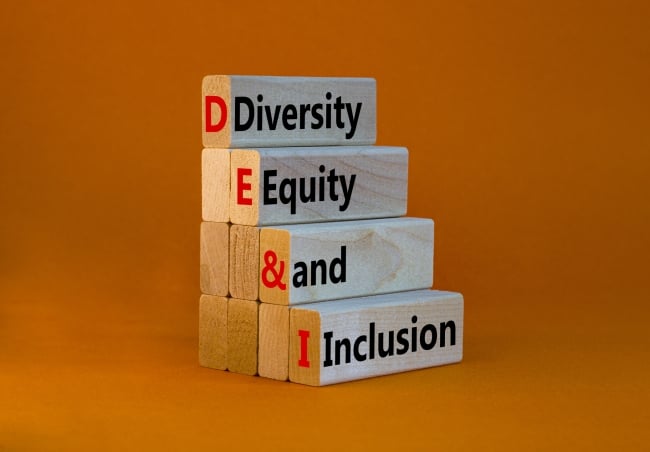You have /5 articles left.
Sign up for a free account or log in.

Dzmitry Dzemidovich/iStock/Getty Images Plus
There’s no denying that DEI is in trouble.
“DEI” (an acronym meaning “diversity, equity and inclusion,” though sometimes with variations including “justice” and/or “belonging”), and the offices and committees associated with it, are under mounting pressure from both outside and inside universities. In the business world, while corporate executives still express commitment to DEI, they are simultaneously drastically changing DEI programs, slowing hiring for DEI-related roles, and reducing their DEI workforces. In Florida and in Texas, state universities have been laying off their DEI staff in response to new laws banning DEI initiatives. In the wake of Hamas’s Oct. 7 attack in Israel and the responses to the Israel-Hamas conflict on U.S. campuses, even the thoughtful and restrained Jonathan Haidt has argued that DEI based on a moralizing form of identitarianism is not compatible with the mission of universities.
All this activity suggests that moves to simply rebrand DEI initiatives on campuses will not be sufficient to stem the tide of opposition. If we want DEI initiatives to continue, they don’t need to be rebranded. They need to be reformed.
DEI offices and committees play many roles on campuses, from offering programming that celebrates various identities, to ensuring compliance with federal law, to advocating for minority students, faculty, and staff, to running trainings about cultural sensitivity. Given the diversity of activity, it’s not obvious how to assess DEI initiatives. Is there a cohesive, overarching goal to DEI work? And if so, how does all this activity fit together to attain it?
Of course, at the most general level, DEI offices and committees exist to promote diversity, equity, inclusion, justice, belonging, and other similar values on campus. But at first blush, there are tensions if not outright inconsistencies among these aims. To take just one example: recently, the chief diversity officer for Johns Hopkins University Medicine resigned following backlash to an internal newsletter about the unearned privilege of whites, heterosexuals, males, Christians, etc. As some have pointed out, here the desire to promote equity for some came into conflict with inclusion and belonging for others. If there are internal inconsistencies in the goals of DEI initiatives, then to succeed at one will be to fail at another. Rather than try to articulate a cohesive goal for the many functions of DEI offices—though I believe one is often sorely lacking—I want to concentrate on the role of DEI in providing training for the university community.
Much DEI programming goes beyond bare compliance to federal law and aims at changing the hearts and minds of faculty, students and staff. It is already well-known that much DEI training is ineffective at best and actively counterproductive at worst (see here, here, here, and here). What I want to argue here is that, as currently practiced, the method of training sessions is at odds with the educational mission of universities.
Frequently, the objective of DEI training seems to be to get students, faculty and staff to see social issues in a particular light—to encourage people to think in intersectional terms, to see privilege or oppression in gender or racial disparities, to view history through the lens of power, and so on—and to embody these views in the university community and beyond. However, there is substantial debate among academics about all sorts of issues related to identity, injustice and the like. While it may seem like education to get students to see social issues through, say, a racial lens, to present this as the best or the only way to see social issues conceals important ongoing debates that education would seek to make them aware of.
For example, leftists like Adolph Reed and Touré F. Reed decry the narrow focus on race as “race reductionism,” arguing that focusing myopically on race (as opposed to analyses based on class, economics and politics) hinders our understanding of complex social phenomena and thereby works against productive class-based solidarity and social change. Even training about various identities risks reifying (i.e., treating as natural and eternal) and reinforcing socially constructed categories when perhaps the right thing to do is to move past them or hold them lightly. While not talking about DEI explicitly, several scholars have made arguments in this vein, perhaps most notably, Kwame Anthony Appiah, Karen E. and Barbara J. Fields, Joan W. Scott, and Wendy Brown.
There are similar debates around nearly all the constructs that DEI initiatives employ: microaggressions, cultural appropriation, colonialism, and so on. To take just one example that many in universities will be familiar with: implicit bias. Recently, Mahzarin Banaji (one of the thinkers behind the Implicit Association Test) and Frank Dobbin wrote that “The research makes it clear that Americans desperately need education about bias, because even people who value fairness and equality hold biases—without being aware of it.” Yet statements like this conceal the fact that within the fields of psychology, philosophy and others, there are substantial debates about the fundamentals of the implicit bias construct: What is bias? Is it always bad? Is “implicit” bias always unconscious or is it, as Banaji and Dobbin (perhaps tellingly) put it, only “less conscious”? Is the construct of implicit bias valid and reliable, and does it have predictive power with regard to behavior? Does it even map onto our ordinary understandings of racism, sexism and other biases?
By its nature, training conceals rather than reveals this kind of complexity. To be efficacious, training must be informative and not deliberative. “Best practices” is the watchword. By contrast, the purpose of education is, as David H. Calhoun characterized Socratic pedagogy, conversion to the philosophical way of life—that is, the goal is for the student to become an active, lifelong inquirer herself. He writes that “the essential mark of Socratic pedagogy” is to help “awaken, give birth to, engage, stimulate, or motivate an active life of intellectual humility, reflection, curiosity, and rational inquiry.” Worse, when trainings are the entry point for students, faculty, and staff to universities, they give a false impression of what a university education is all about, making the educational objectives of universities harder to attain. University education isn’t about coming to the one true view, but the joy of inquiry. In short, when DEI offices and committees engage in training meant to produce compliance with a fixed, prescribed outlook rather than to invite students, faculty and staff to the life of inquiry, they are engaged in work that is anathema to the educational mission of universities.
So, what should we do? We should reform DEI initiatives so that they align with the educational mission of universities. Many DEI-related concepts, like implicit bias, while probably not appropriate as an element of training, are nevertheless ideal topics for inquiry. Not only should universities be talking about issues touching on identity, bias, social justice and the like, they should be at the forefront of such discussions, not simply echoing the current zeitgeist. How precisely this should be done would be best left up to individual educators in specific contexts. But, in general, DEI-oriented education should embody what goes on in the best university classrooms and would therefore, I expect, share some common features.
First, while trainings are frequently monologic and unidirectional, it is a hallmark of a good university education that it is dialogic and bi-directional. A recent report from the U.K.-based More in Common shows that “People far prefer EDI [Equality, Diversity and Inclusion] activity that is in person and, crucially, feels part of a two-way discussion”; the report also notes that “the most prominent criticism of EDI activity among the public is that diversity policies and practice can be used to silence, or even to chastise people.” Universities would be wise to take note of this finding.
Second, a good university education is characterized by inviting people to view the world through multiple lenses rather than trying to enforce one way of looking at social reality. The world is complicated, and members of university communities more than anywhere else should be fluent in seeing the world through a variety of lenses—including through the conceptual lenses usually associated with DEI.
Third, in a good university education, the concepts and constructs presented are themselves up for scrutiny and discussion. The tenor of training is often “here are the new ideas so you can be up to date,” while education offers, “here’s a new way of thinking about this issue—do we find it useful or not?”
While I disagree sharply with the idea that the purpose of a university education is job training, there are, I think, market advantages to this approach to DEI. After all, it’s not unreasonable to think that employers would be more inclined to hire people who are thoughtful about identity and cultural issues and fluent in dialoguing about them than simply those who know and want to enforce a “party line.”
Importantly, if DEI were reimagined along these lines, there should be a clear division of labor. If universities desire to have programming celebrating various identity groups, then that would likely be left to offices of residence life or student affairs. Compliance with federal law would be a matter for human resources departments and Title IX offices. Roland Fryer has recently argued that “DEI at its best is about developing talent, measuring it in a fair way, selecting the best people for important roles, and finding hidden talent in a world where not everyone has an equal chance to exhibit their abilities.” If universities want to optimize talent in this way, then that would probably be best served by consultants who are retained only insofar as there is a need for institutional direction.
Crucially, in this division of labor, DEI education should be squarely under the purview of faculty. If universities are really committed to DEI, they must demonstrate that by investing in faculty with the proper expertise—historians, philosophers, sociologists, political scientists, and the like—to guide the conversation Socratically.
To be sure, some will object that this way of reimagining the educational mission of DEI—run by faculty, after all—would be nothing but talk. How would we effect the kind of personal transformation and social change that many DEI advocates desire? However, I would argue that the most effective way to promote personal transformation and social change is through education—through an invitation to the philosophical way of life. Training doesn’t foster personal transformation or social change; it fosters compliance.
There are many who want to simply throw in the towel on DEI. But properly reimagined and reformed, DEI is part and parcel of what the mission of the university always has been—inquiry and education. It is high time that we have necessary conversations about what the purpose of DEI work is on our campuses and reform accordingly. Otherwise, the decision may be made for us.




